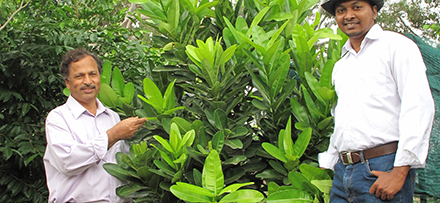
PhD scholar Subhash Hathurusingha and Assoc Prof Nanjappa Ashwath with a Beauty Leaf tree growing on campus
As Australia pushes forward in its net zero emissions commitments, some believe the key to a greener fuel could be hidden in the oil-rich seeds of the native Beauty Leaf tree. Sources: CQ University, ABC News
Bioenergy is when low-emission electricity is extracted from waste, with fuel sources often coming from the agricultural and forestry industries.
But CQ University researcher Nanjappa Ashwath says he has found the beauty leaf tree can be grown on marginal land, ending the food-versus-fuel land-use debate that has plagued the biofuel sector.
“The tree produces about 10,000 fruits per tree per year, which equals to it producing up to 4,000 litres of biodiesel per hectare per year – and that’s growing up in a really marginal soil,” he said.
Associate Professor Ashwath describes the tree as being similar to a medium-sized mango tree, or a macadamia tree with seeds and a kernel inside but with a softer shell.
He said the biofuel produced within that shell had been tested in engines with just a “slight reduction in power” compared with traditional petroleum diesel. It performed similarly to other biodiesels.
Dr Ashwath said in good news for time-poor producers, the seeds did not require harvesting as they naturally fell to the ground and could be collected up to six months later.
He said the oils of the tree could also be made into the less-profitable medicinal Tamanu oil, with 15 millilitres costing about $25.
“That supplied whole oil as the medicine is a limited market, whereas if you use the same oil for biodiesel production, the scope it’s not limited because 80% of fuel [in Australia] is imported,” he said.
Dr Ashwath said his research showed the plant grew well in soil which was not rich in nutrients.
And while it did not grow in drought, he said it tolerated hot and dry conditions as well as waterlogging, making it a suitable plantation for areas in northern Australia from Rockhampton up to Cairns, including around Darwin.
The federal government outlined its commitment to bioenergy in its release of the first Bioenergy Roadmap in November.
The roadmap says that by the start of the next decade, the sector could contribute about $10 billion in extra GDP per year with 26,200 new jobs, reducing emissions by 9% and enhancing fuel security.
It also predicts bioenergy could grow from 3% of Australia’s total energy consumption to up to 20% by the 2050s.
Dr Ashwath said overall demand for biodiesel remained low because it was still cheaper to buy traditional petroleum diesel, but other countries were showing interest in the beauty leaf tree.
“There are many inquiries, especially in Indonesia [where] they’re establishing quite large plantations, especially in the islands where they don’t have the supply of the petroleum diesel,” he said.
“Papua New Guinea is also interested in growing these because these plantations occur naturally, and Sri Lanka is also doing quite a lot of research on it.”
But Dr Ashwath said for producers looking for extra income, plantations of thousands of hectares would be required to turn a profit.







